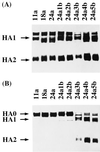Generation of a highly pathogenic avian influenza A virus from an avirulent field isolate by passaging in chickens
- PMID: 11287597
- PMCID: PMC114193
- DOI: 10.1128/JVI.75.9.4439-4443.2001
Generation of a highly pathogenic avian influenza A virus from an avirulent field isolate by passaging in chickens
Abstract
Highly virulent avian influenza viruses can arise from avirulent strains maintained in poultry, but evidence to support their generation from viruses in wild birds is lacking. The most likely mechanism for the acquisition of virulence by benign avian viruses is the introduction of mutations by error-prone RNA polymerase, followed by the selection of virulent viruses. To investigate whether this mechanism could apply to wild waterfowl, we studied an avirulent wild-swan virus that replicates poorly in chickens. After 24 consecutive passages by air sac inoculation, followed by five passages in chicken brain, the avirulent virus became highly pathogenic in chickens, producing a 100% mortality rate. Sequence analysis at the hemmaglutinin cleavage site of the original isolate revealed a typical avirulence type of sequence, R-E-T-R, which progressed incrementally to a typical virulence type of sequence, R-R-K-K-R, during repeated passages in chickens. These results demonstrate that avirulent viruses maintained in wild waterfowl in nature and bearing the consensus avirulence type sequence R-E-T-R have the potential to become highly pathogenic while circulating in chickens.
Figures
References
-
- Bean W J, Sriram G, Webster R G. Electrophoretic analysis of iodine-labeled influenza virus RNA segments. Anal Biochem. 1980;102:228–232. - PubMed
-
- Bosch F X, Orlich M, Klenk H-D, Rott R. The structure of the hemagglutinin, a determinant for the pathogenicity of influenza viruses. Virology. 1979;95:197–207. - PubMed
-
- Brugh M, Beck J R. Recovery of minority subpopulations of highly pathogenic avian influenza virus. In: Easterday B C, Beard C W, editors. Proceedings of the 3rd International Symposium on Avian Influenza. Madison, Wis: University of Wisconsin—Madison; 1992. pp. 166–174.
-
- Easterday B C, Hinshaw V S, Halvorson D A. Influenza. In: Calnek B W, editor. Diseases of poultry. 10th ed. Ames: Iowa State University Press; 1997. pp. 583–605.
Publication types
MeSH terms
Substances
LinkOut - more resources
Full Text Sources
Other Literature Sources


